



Four homes have been destroyed and more than 120 are threatened by a wildfire in Sonoita, officials said Wednesday morning.
Some 100 firefighters are fighting the Encino Fire which they say so far has burned eight structures, including the four homes, and spread to more than 1,300 acres, officials said.
Power is out in a lot of the area because several power poles were burned, though crews were working to restore power where it is safe to do so.
The Encino Fire began about 8 p.m. Tuesday forcing evacuations around Sonita, which is about 45 miles southeast of Tucson.
No injuries have been reported.
Two shelters have been set up — one at the Sonoita Fairgrounds and another at Harvest Christian Fellowship Church, authorities said.
Officials said Wednesday the cause of the fire is unknown, but there was lightning in the area.
Firefighters are dealing with extreme heat today as they battle the fire. Air resources are assessing whether they need to use retardant.
Officials will make sure firefighters are hydrated and safe during the heat wave that has brought extreme temperatures to parts of Arizona, said Tiffany Davila, a spokeswoman for the Arizona Department of Forestry and Fire Management told the Associated Press today.
Mark Beres of Flying Leap Vineyards said Tuesday night that he could see the flames and smoke from his property, which is on Elgin Road, a couple miles from what he believes is the fire’s epicenter.
“I’m standing in our winery right now and I can see the flames and I can see the smoke. I would say it’s five miles from our property,” he said Tuesday night as “the wind out here is blowing like mad and it’s raining.”
Beres said he saw lightening strikes “burning down the southern sky” along the surrounding mountain ranges.
Fellow Sonoita winemaker James Callahan of Rune Wines at 3969 Arizona Highway 82 said he saw the flames and saw structures burning.
Beres said Sonoita, with its dry grasslands, is a tinder box. He drove in from his home in Tucson to the winery and along the way, he “saw truck after truck after truck hauling livestock. There’s a lot of livestock grazing out here now.”
“I’m just hoping everybody is safe,” he said.
==============
June 21: Encino Fire destroys 4 homes
The Encino Fire burning in Sonoita has burned four homes and spread to about 1,300 acres since it sparked on Tuesday.
Another 122 homes are threatened, according to Chief Joseph De Wolf of the Sonoita-Elgin Fire District.
One firefighter with the U.S. Forest Service suffered a broken ankle and was transported to a Tucson hospital Tuesday evening, De Wolf said.
Wolf said the upcoming heat of the day would pose a significant challenge but that his goal was to have residents back in their homes by Wednesday night.
June 20: Evacuations issued in Sonoita
A new, "rapidly spreading" wildfire was sparked on Tuesday in southern Arizona, prompting officials to issue evacuation notices in Sonoita, a small area about 50 miles southeast of Tucson.
The notices were issued for residents on Boyd, Toledo and Terry roads, as well as Apache Trail, Holbrook Drive and all adjacent streets, according to the Santa Cruz County Sheriff's Office.
"Last report received was of three homes that have been destroyed and many others remain threatened,'' the Sheriff's Office said on its Facebook page Tuesday night.
Officials said evacuees can find refuge at the Sonoita Fairgrounds or the Harvest Church at 3107 Highway 83.
No further details were immediately available.
June 18: Highline Fire evacuation orders lifted
The Highline Fire near Payson expanded by several hundred acres since Saturday and has now reached 6,092 acres with 60 percent containment as of Sunday afternoon, according to the Tonto National Forest.
The slow growth and large containment prompted officials to lift the evacuation and pre-evacuation orders for residents and local businesses in the Bonita Creek, La Cienega and Ellison Creek Estates north of the control road in the fire area, according to the Gila County Sheriff's Office.
Officials said the progress made in the last two days gave them confidence to deem evacuations unnecessary.
All road closures remain in effect around the perimeter of the fire, with officials only granting access to residents and local business traffic.
There are 1,243 fire personnel working on combating the fire.
Crews tonight will focus on the southeast portion of the fire above La Cienega and Ellison Creek Estates, officials said.
Structure protection groups will remain in place in the communities south of the fire, while crews on the northwest side of the fire will conduct burnout operations to limit fire movement north, officials said.
The Boundary Fire, burning on Kendrick Mountain 17 miles northwest of Flagstaff, has reached 7,367 acres and was 18 percent contained as of Sunday afternoon, according to officials with the Kaibab National Forest.
Just under 400 personnel were working to combat the fire on Sunday.
North winds overnight on Saturday pushed light smoke into some communities near Flagstaff early Sunday morning, but officials said most smoke was cleared by dawn.
Northeast winds on Sunday are expected to push smoke toward Williams and Bellemont, with officials advising individuals sensitive to smoke to stay indoors.
The closure on Highway 180 between mileposts 236 and 248 remains in effect.
June 17:
The Highline Fire near Payson has reached 5,737 acres with 44 percent containment as of Saturday morning, according to Mike Reichling from the Southwest Area Incident Management Team.
There are 1,240 working firefighters who made success on the east and west sides of the fire Friday night, Reichling said.
Ellison Creek and La Cienega estates are still under evacuation and will remain under evacuation today.
Bonita Creek will be under evacuation notice as of today.
Oficials also said humidity is "critically low" and temperatures are rising, so fire behavior may be very active.
Crews will be working on the north end of the fire today in hopes of containing it, according to officials.
June 16: Flames stop short of community
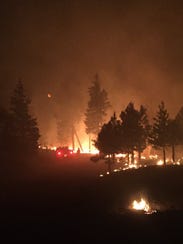
The Highline Fire near Payson has reached 4,929 acres and 35 percent containment as of Friday morning. (Photo: U.S. Forest Service)
The Highline Fire made its way down the hills of Gila County and toward the Payson communities of La Cienega and Ellison Creek Estates on Thursday night, but stopped short of a fire line built near homes.
Calm and shifting winds on Friday and Saturday are expected to slow the fire's advance and redirect its spread, pushing the flames on top of each other.
"We expect them to push back up the canyon, pushing the fire into itself," a fire team spokesman said Friday morning.
Evacuation orders are still active for La Cienega and Ellison Creek Estates, though the emergency shelter at Payson High School stayed empty overnight. A few people checked in, stopping by for a free dinner or the latest fire update, but left to stay with family or friends.
The Highline Fire near Payson has reached 4,929 acres and 35 percent containment as of Friday morning.
There are 1,069 firefighters working on the Mogollon Rim, said Mike Reichling, public information officer for the Southwest Area Incident Management Team.
He added that the Mogollon Rim is a challenging area due to the changes in elevation.
Humidity percentage is in the single digits, which makes fire behavior "very erratic because of winds drying out fuels."
Firefighters will be working on the southeastern and western portions; however, they are concerned about using aircrafts.
Because of elevation and heat, aircrafts are limited in their abilities to drop water and retardant, Reichling said.
In addition, 10 people were evacuated from the southeastern side of the fire but three stayed, despite the evacuation orders, according to Reichling.
He said the three that stayed signed forms stating that they understand the risk.
June 15: Evacuations ordered after fires merge
The Highline Fire near Payson has merged with a second wildfire, the Bear Fire, and the combined blaze now has burned over 4,258 acres, officials said Thursday.
An evacuation order was later issued for La Cienega and Ellison Creek Estates northeast of Payson, according to the Tonto National Forest.
The order does not affect the Bonita Creek Estates community, which is still under a pre-evacuation notice.
The evacuations were prompted by "rapid fire movement towards the community," officials said, adding that they were concerned that the fire could reach the community overnight.
The evacuation order became effective 7:30 p.m. Thursday.
Residents will not be allowed in until the area is deemed safe again.
A Red Cross shelter is set up at the Payson High School. Large animals can be brought to the Payson Multi-Event Center.
The Highline Fire had been moving toward the Bear Fire, and the two merged Monday. They are now being managed as one fire, the Forest Service said in a press release.
The fire continues to challenge firefighters to the east as it burns in upper Ellison Canyon.
Updates for the Highline Fire can be found at @HighlineFire on Twitter.
June 14: Highline Fire near Payson expands
The 4-day-old Highline fire burned eastward through upper Moore Creek, onto the Myrtle Trail and into upper Ellison Creek as firefighters worked to suppress the flames overnight, officials reported Wednesday.
The fire north of Payson had expanded to more than 1,300 acres, officials said.
Crews used air tankers to slow the fire's progress above the Rim and used strategic fire operations south of the 300 Road at the Rim overnight. The blaze started about 8 miles north of Payson.
Moving forward, firefighters look to hold the fire north of the Highline Trail, south of the 300 Road and create a new line of protection at the head of Ellison Creek.
No evacuations are in effect, though the community of Bonita Creek remains under a precautionary pre-evacuation notice.
Updates for the Highline Fire can be found at @HighlineFire on Twitter.
June 13: Highline Fire lines hold
Crews strengthened fire lines along the north side of the Highline Fire on Tuesday. The U.S. Forest Service said in a press release that crews faced rolling debris and other hazards as they battled the fire, which is burning in steep terrain near Payson.
No evacuations are in effect, though the community of Bonita Creek remains under a precautionary pre-evacuation notice. A community meeting will take place at 6 p.m. Tuesday at the Starlight Pines Community Center in Blue Ridge.
Coconino National Forest and Kaibab National Forests will restrict campfires to developed campgrounds beginning Thursday. Campfires, charcoal and wood stoves are prohibited.
June 12: Fires keep communities on edge
Firefighters continued to battle the Highline Fire near Payson on Monday. The 750-acre blaze moved quickly up the Mogollon Rim when it started Saturday, and by Monday the Forest Service said in a press release that crews had 460 people working day and night for full suppression.
No evacuations were ordered, though a precautionary notice was issued for residents of Bonito Creek Canyon. A community meeting will take place 7 p.m. Monday, June 12 at the Payson High School auditorium, 301 S. McLane Road.
A cold front could bring high southwest winds to the fire, which is burning in rugged terrain with grass, thick brush, oak and ponderosa pine.
Firefighters were using helicopters, back burns and air tankers. Crews from the nearby Bear Fire battled spot fires north of Forest Road 300 and built a fire line with a bulldozer.
A number of trails in the area have been closed.
In southeast Arizona, the Lizard Fire continued to burn near Dragoon. Firefighters expected dry, windy conditions, which failed to materialize, giving them the opportunity to work the fire’s eastern flanks.
Evacuations were ordered Monday afternoon in the Cochise Stronghold area, beginning at the intersection of Cochise Stronghold and Ironwood Road and including everything west and south from there. A pre-evacuation will remain in the Redhead area, according to the Sheriff's Office.
The fire, which merged with the Dragoon Fire last week, has burned 14,954 acres and is 15 percent contained, according to InciWeb, a multi-agency web site dedicated to wildfire.
Helicopter water drops helped crews working to protect structures in the area.
The lightning-caused fire has 615 firefighters working toward suppression of the fire, which is burning near the communities of Dragoon, Pearce, Sunsites and Cochise Stronghold.
June 11: Highline Fire burns northwest of Payson
The Highline Fire, which ignited Saturday afternoon, spread to cover 750 acres near the Mogollon Rim on Sunday.
The expansion spurred Coconino National Forest closures, including Knoll Lake, the General Crook Trail and parts of the Cabin Loop Trail System.
Firefighters were "working around the clock" to suppress the fire, officials said, with units using hand crews, engines, water tenders, dozers, helicopters and air tankers.
No evacuation orders were in effect as of Sunday night.
June 11: Tee Fire burns near Black Canyon City
The Tee Fire began burning around 7 p.m. Saturday night about 4 miles away from Black Canyon City and near Table Mesa.
Tiffany Davila, a representative for Arizona Department of Forestry and Fire Management, told The Republic that the Maricopa County Sheriff's Office was working with the department to ensure nearby campers had evacuated the area. Davila said there weren't any nearby structures for the fire to endanger.
The fire's estimated to be roughly 700 acres.
June 10: 2 fires merge; power threatened
The Lizard Fire has merged with the Dragoon Fire in the Coronado National Forest east of Tucson and is moving south.
The Cochise County Sheriff's Office has evacuated residents south of Dragoon Road and in the Cochise Stronghold. Pre-evacuation warnings have been issued in other nearby areas.
Power lines in Cochise County are being threatened, and some of the lines may be shut off.
The fire has spread over 7,500 acres.
June 10: U.S. 180 north of Flagstaff still closed
In northern Arizona north of Flagstaff, U.S. 180 remains closed due to smoke from the Boundary Fire.
The lightning-caused fire is burning on the northeast side of Kendrick Peak and includes areas in both the Coconino and Kaibab national forests.
The fire has spread to 3,800 acres, according to fire officials. it is expected to remain active for the next few days as forecasts call for high winds.
June 8: Fires reported in southeast Arizona
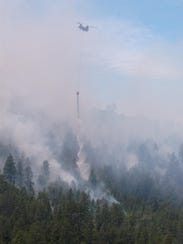
A Chinook helicopter drops water onto the Freeze 2 Fire on Sunday, June 11, 2017. (Photo: U.S. Forest Service)
Multiple fires have been reported in southeast Arizona. Five of them were "significant," said Dolores Garcia, a spokeswoman for the Bureau of Land Management. Firefighters were battling some of them aggressively because of possible threats to homes and other structures. Among them is the Lizard Fire, which was spread over 3,500 acres on Thursday, June 8.
Meanwhile, increased winds near the Boundary Fire north of Flagstaff forced a closure of U.S. 180 between mileposts 236 and 248, according to a press release from the U.S. Forest Service.
The multiagency website InciWeb reported that access to the Ten of Diamonds area of the Black River was closed because of the Freeze 2 Fire. The closure includes access points from both Fort Apache Reservation and San Carlos Reservation. The fire is burning on the San Carlos side of the river.
The Antelope Fire, near Kingman, was also being watched closely because of "threats to homes," Garcia said.
Many of the fires were lightning-caused, though others remain under investigation.
June 7: Boundary Fire grows
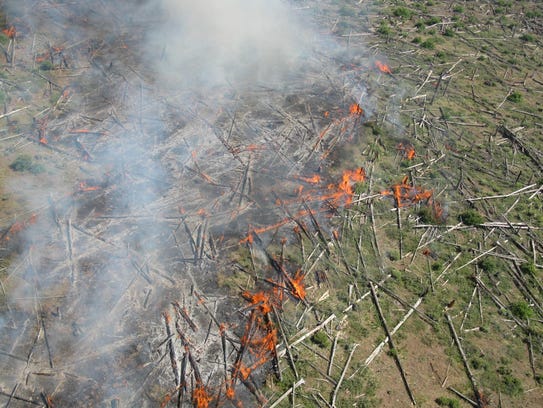
The Boundary Fire in the Kaibab National Forest has burned 550 acres on June 8, 2017. (Photo: InciWeb)
The Boundary Fire began burning Wednesday afternoon 17 miles northwest of Flagstaff, officials said.
Lightning caused the fire to break out on the northeast side of Kendrick Peak in the Kendrick Mountain Wilderness just before 4:30 p.m.
As of Wednesday evening, the fire had consumed 450 acres and was being fueled by heavy dead and down trees as well as forest debris left from the Pumpkin Fire of 2000, officials said.
The fire was expected to move onto the Kaibab National Forest side of the boundary line within the next several days.
Increased winds are expected over the next few days in the area.
June 7: Slim Fire at 3,000 acres
The Slim Fire is burning about 4 miles north of Forest Lakes in the Apache-Sitgreaves National Forests.
The lightning-caused fire was reported June 2 and had grown to about 3,000 acres by Wednesday evening, according to officials.
The fire, which was about 16 miles west of Heber, was burning in Ponderosa pine and mixed conifer.
The fire was 30 percent contained Wednesday, with 304 personnel battling the blaze.
The fire is expected to be fully contained by June 30.
Officials said a flight restriction is in effect over the area, which includes drones and unmanned aerial vehicles.
June 7: Snake Ridge Fire fully contained
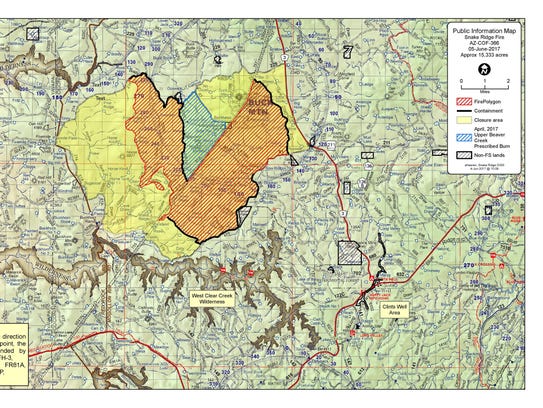
A boundary map of the Snake Ridge Fire. Officials said Monday, June 12, 2017 that the fire southeast of Sedona was fully contained. (Photo: U.S. Forest Service)
A 15,333-acre wildfire near Happy Jack, southeast of Sedona, was fully contained as of Monday, officials said.
Firefighters began a burnout Sunday morning that they expected would last several days, according to officials.
Burnout activity began around 8 a.m. Sunday as firefighters attempted to contain the fire by mid-week. Crews plan to direct the fire to burn away from property and trail heads for another 15,000 acres for approximately two more weeks.
Smoke drifted toward the northern Arizona communities of Holbrook, Snowflake and Show Low on Sunday and Monday, officials said. Throughout the burnout, smoke was visible from communities along Lake Mary Road, State Routes 87 and 260, and other Verde Valley cities.
The fire ignited due to lightning on May 19 about nine miles northwest of Clints Well, around 10 miles southwest of Happy Jack.
The area around where the fire burned continues to be closed to the public, officials said.

Kaitlyn Webb from the U.S. Forest Service explains how a prescribed burn is conducted and how it helps the forest.
June 2: Roads open near Kellogg Fire
Firefighters secured the perimeter of the Kellogg Fire and turned mop-up operations over to local crews on Friday. The fire burned 780 acres of grasslands near the southeast Arizona town of Sonoita, forcing road closures and evacuations. Two barns were burned in the wind-driven blaze, but evacuations have been lifted and roads have reopened.
“I think our crews got a good handle on it yesterday,” said Tiffany Davila, a spokeswoman for the Arizona Department of Forestry and Fire Management. The evacuations were largely a precaution because the fire was so close to residential areas.
“Anytime you’ve got a wind-driven fire. It can move pretty quick," Davila said.
June 2: Badger Fire nearly contained
Firefighters hoped to see 100 percent containment on the Badger Fire by nightfall, said Dolores Garcia, a spokeswoman for the U.S. Bureau of Land Management. Both lanes of Interstate 17 north of Phoenix were open going into the weekend. Garcia said drivers may see some smoke in the area. She encouraged motorists to report smoke if they are unsure where it is coming from.
“We’re going to see, unfortunately, roadside fires, as long as there’s grass along the side of the road,” she said.
June 1: Kellogg Fire forces evacuations
A fast-moving brush fire that sparked Thursday afternoon in Sonoita burned about 250 acres within an hour of its start and forced 15 homes to evacuate, officials said.
The Kellogg Fire broke out about 1 p.m. just south of State Route 82 and north of Old Sonoita Highway, the latter of which is closed.
June 1: Badger Fire stop straffic
Separately, a brush fire alongside Interstate 17 near Cordes Junction brought traffic to a standstill on northbound lanes Thursday afternoon, officials said. The Badger Fire apparently started when a vehicle broke down and was forced to pull off to the side of the road, sparking dry vegetation about 2 p.m.
The fire, which burned more than 60 acres, was controlled in a few hours and the highway reopened about 4:30 p.m., officials said, after traffic backups reached 8 miles.
— Josiah Destin
June 1: Exploding balls fighting blazes
National forest crews have been fighting fire with fire in the last week by dropping combustible spheres that resemble ping-pong balls from helicopters to help control a lightning-caused blaze in Arizona.
The devices are filled with flammable substances that cause them to ignite once they hit the ground. By using the exploding balls, authorities didn’t have to send firefighters into unsafe and remote areas.
“The flammable spheres burn out in a circular pattern on the forest floor, as each circle of fire slowly grows they eventually burn into each other,” said Kaitlyn Webb, a spokesperson for Coconino National Forest.
The fire started on May 19 roughly 8 miles southwest of Happy Jack and has since covered more than 12.5 square miles, Incident Commander trainee Jason McElfresh said.
Authorities expect to soon have the fire contained.
— Associated Press
May 30: Restrictions in Prescott National Forest
Fire restrictions will go into effect in Prescott National Forest at 8 a.m. June 1. Campfires and charcoal and wood stoves will only be allowed in developed campsites and recreation sites with metal rings or grills until the ban is lifted.
Smoking is prohibited except in vehicles, buildings or developed recreation sites. Smokers are required to remain in an area at least three feet in diameter that is barren or cleared of all flammable materials.
Target shooting is also prohibited under the ban.
Dry, windy conditions and a number of abandoned campfires over the Memorial Day weekend led to the ban, the Forest Service said in a news release.
A wet winter brought relief throughout Prescott National Forest, but the moisture also helped grass grow, and that grass is drying. Tall grass can make fires difficult to control.
For a list of campgrounds where fires and charcoal are allowed, call 928-777-5799 or go to the Prescott Forest website.
May 30: Fire near Tortilla Flat burns 150 acres
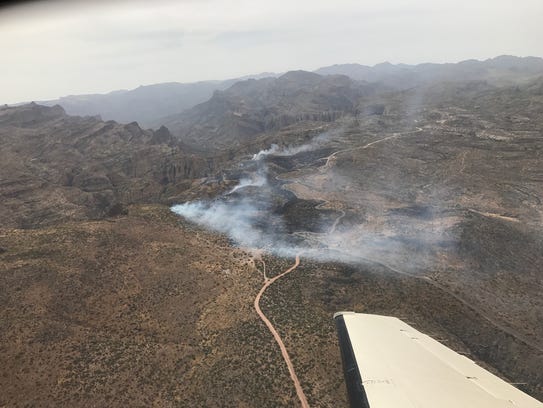
Tortilla Fire on State Road 88, east of Tortilla Flats. (Photo: Jonnie VanDerHoeven)
A brush fire that ignited near Tortilla Flat in the early morning May 30 had burned about 150 acres and was about 80 percent contained by midafternoon, according to the U.S. Forest Service.
The fire burned close to State Route 88, and the Arizona Department of Transportation shut down a 13-mile stretch of the highway for most of the morning and into the afternoon.
The fire was reported about 6:30 a.m. near Tortilla Flat, said Carrie Templin, a Tonto National Forest spokeswoman.
"The fire is human-caused, but at this time we don't have any additional information. It is under investigation," she said.
May 29: Firefighters contain Joe's Hill Fire
Firefighters contained the Joe's Hill Fire about noon May 29, according to the Daisy Mountain Fire Department.
Six structures were lost in the fire, including a mobile home and storage facilities, the department released.
The fire ignited in Black Canyon City on the afternoon of May 27, was controlled, then jumped containment lines and eventually grew to 50 acres, leading to evacuation orders for about 35 residents.
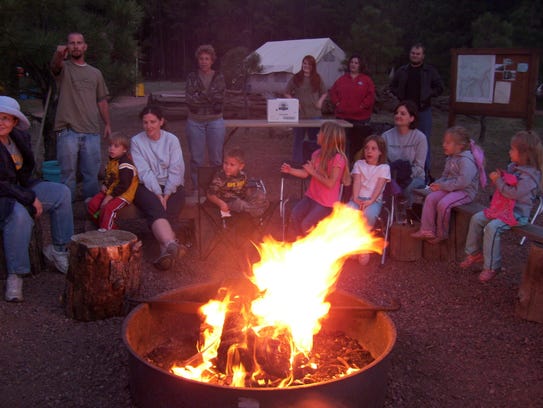
As temperatures rise and vegetation dries out, land managers are restricting campfires to metal fire rings in developed campgrounds. (Photo: Special for The Republic)
The evacuation orders in Black Canyon City were lifted on the evening of May 28 as firefighters gained about 50 percent control of the fire that started in a salvage yard Saturday.
The American Red Cross closed the shelter it set up for about 20 people who were forced from their homes, including two people who lost their homes, the organization said.
Those two people, as well as one person who was placed in a hotel for health concerns during the fire, will be provided follow-on services from the Red Cross, the organization said.
May 28: Joe's Hill Fire expands to 50 acres
About 200 firefighters were battling a 50-acre blaze that forced evacuations for about 20 homes in Black Canyon City and destroyed six structures.
The Joe's Hill Fire broke out again late May 27 in a salvage yard, according to the Department of Forestry and Fire Management.
"We're looking at about 35 residents that have been evacuated," said Daisy Mountain Fire Chief Mark Nichols.
Officials hope to have the fire suppressed by 6 p.m. May 29, according to The Department of Forestry and Fire Management.
The fire was initially contained by local fire departments, but the Department of Forestry and Fire Management said that the fire started back up under suspicious circumstances later that night.
The cause of the fires is not currently known, and is under investigation according to the department.
"We're doing an evaluation of the fire right now," Nichols said.
There have been no additional evacuations and no permanent structures damaged outside of the facility where the fire started, according to the department.
"We've lost a couple structures but we don't have an exact count. We're thinking we've lost up to six," Nichols said.
Nichols was confident that the firefighters would be successful in their suppression efforts.
"Everything is looking good so far," he said.
May 28: Residents near Joe Hill Fire evacuated
Just after 11 p.m. May 27 a fire, dubbed the Joe Hill Fire, broke out at the C and S, an auto salvage yard on Smitty Way at Tara Springs Road in Black Canyon City, authorities said.
An initial brush fire in the area had been thought to be extinguished, but continued to burn, affecting the yard.
Crews worked overnight to contain the fire, which was reported to be at 15 acres on the morning of May 28, It was an multi-agency effort, involving about 240 firefighters from Black Canyon, Daisy Mountain, Scottsdale, Paradise Valley, Phoenix and Glendale fire departments.
Residents in the vicinity were evacuated as a precaution, with a shelter set up at the Canon School near Velda Rose and School Loop roads.
No further evacuations were expected as of 6 a.m. Sunday, but the Red Cross said they will remain on hand to provide support
May 27: Road closures for Pinal Fire expands
The Pinal Fire closure order has been expanded to include portions of three roads and an additional area, authorities said.
The revisions will remain in effect until July 31, or until the Pinal Fire has been mitigated.
The portion of Forest Road 55, locally known as Russell Road, has been closed from the Tonoto National Forest boundary south to the intersection of Forest Road 652, as well as east to the intersection with Forest Road 112C.
The portion of Forest Road 157, from the forest boundary south to the intersection with Forest Road 55.
The portion of Forest Road 112C from the intersection with Forest Road 55 in Kellner Canyon, southeast to the intersection with Forest Road 112 in Icehouse Canyon.
The portion of national forest land between Forest Road 55 and Forest Road 157, south from the forest boundary to the intersection of the above three roads at Tuxedo Junction.
May 27: Black Canyon City structures at risk
A one-acre fire ignited in Black Canyon City on the afternoon of May 27, threatening multiple structures and spreading to a vehicle storage yard, authorities said.
Shortly before 7 p.m., 24 units were on the scene, mostly from Daisy Mountain and Black Canyon fire departments. The fire was near the 21000 block of East Smitty Way.
May 27: Forest closures in Snake Ridge Fire
The lightning-caused Snake Ridge Fire had grown to 4,850 acres on May 27 and was still creeping across the forest floor in the Coconino National Forest.
Forest closure areas have been expanded to the north and east of the fire area, which is about nine miles northwest of Clints Well and several miles west of Lake Mary Road.
Smoke is expected to be visible along Lake Mary Road, on state Routes 87 and 260, and in nearby communities and the Verde Valley over the next several days.
May 27: Pre-evacuation order in Pinal Fire
The Pinal Fire burning south of Globe had scorched more than 6,400 acres of land by the morning of May 27.
On Friday, officials issued a precautionary pre-evacuation notice to some residents in the area, the Gila County Sheriff's Office said.
The notice only affects residents in the Icehouse and Kellner canyons who are south of the Icehouse and Kellner junction, southwest of Globe.
Officials stressed that residents do not need to leave the area at this time, adding that the precautionary notice is because of a change in the fire's "weather and fuel conditions."
Local public-safety personnel will go door to door to give residents information about the pre-evacuation procedures, the Sheriff's Office said.
The Sheriff's Office said residents should start making preparations now in case an evacuation becomes necessary.
Residents with livestock can choose to shelter their animals at the Burch Sale Yard, officials said, adding that the Phoenix Humane Society would assist in providing shelter for pets if necessary.
More than 600 personnel were working on combating the fire, almost double the number from Wednesday.
On Wednesday, the fire had consumed about 4,300 acres.
The Pinal Fire is the first naturally caused fire to spread through the area in 65 years, starting from a lightning strike on the afternoon of May 8. The fire is being fueled by timber and chaparral in the area, officials said.
Fire officials determined early on to treat the fire as a controlled burn because the area had not burned naturally in so long, while keeping crews in place to prevent it from crossing containment lines.
Residents with questions were asked to call the Pinal Fire Incident Command Center at 928-487-0676.
The Tonto National Forest said the fire was expected to be contained by June 15.
May 27: Authorities issue drone warning
Firefighters spotted four drones flying illegally near the Pinal Fire, according to the U.S. Forest Service.
The drones have hindered firefighting operations, prompting the agency to repeat its message that drones are not allowed near wildfires.
When drones are in the area, firefighters ground their aircraft. Helicopters are particularly susceptible to collisions, even with smaller objects, and so it is considered unsafe to fly with a drone in the air.
One drone operator has been cited for flying near the Pinal Fire.
Drone operators who violate the law "may be subject to civil penalties, including fines of up to $25,000, and potentially criminal prosecution," the agency said in a news release.
The fire, which has burned about 6,418 acres since May 8, is being allowed to burn in some areas but contained in others. Firefighters had to ground a tanker releasing retardant until one of the drone issues was resolved, the Forest Service reported.
May 24: Fire restrictions imposed in southeastern Arizona, Tonto Forest
Dry conditions have triggered fire restrictions throughout southeast Arizona, including Coronado National Forest, where campfires are banned except in developed campgrounds.
Charcoal fires, smoking, target shooting, welding and smoking are included in the ban, which was announced in a multiagency press release.
Camp stoves are allowed. Fires are allowed in metal fire rings at campgrounds but must be extinguished when you leave the campsite.
The ban also covers a number of national parks and monuments, state lands and the Gila District of the Bureau of Land Management. Although there is no camping where some of the restrictions apply, smoking is restricted to vehicles, buildings, developed recreation sites or barren areas at least 3 feet in diameter clear of all flammable materials.
The national parks and monuments are:
Saguaro National Park
Casa Grande Ruins National Monument
Coronado National Memorial
Chiricahua National Monument
Fort Bowie National Historic Site
Tumacácori National Historical Park
Organ Pipe Cactus National Monument
State lands in Cochise, Graham, Greenlee, La Paz, Pima, Pinal, Santa Cruz and Yuma counties are also under fire restrictions.
Tonto National Forest announced a ban last week.
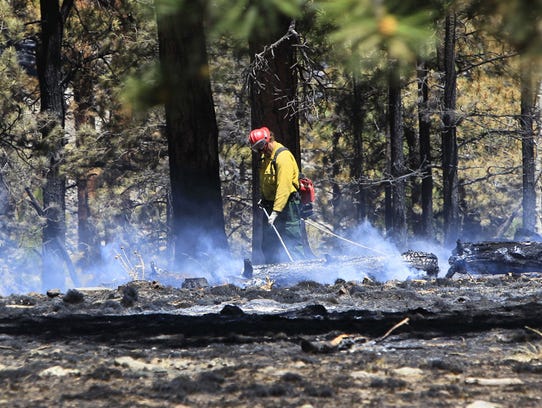
(Photo: Nick Oza/The Republic)
Fire restrictions in effect for Tonto Forest
Tonto National Forest has imposed fire restrictions, banning open campfires and other activities that may spark a wildfire.
Rising temperatures have prompted the agency to restrict fires to metal fire rings in developed campsites, which means campers in undeveloped areas must use stoves, lanterns and heating devices.
The agency has also banned welding equipment, chain saws, or "operating combustion engines without spark-arresting devices," the agency said in a press release.
Target shooting is prohibited while the restrictions are in place. Hunting is allowed. Fireworks and explosives are prohibited year-round. Exploding targets and tracer rounds are illegal on public lands.
Smoking is prohibited except within an enclosed vehicle or building, or at a developed recreation site as long as butts are not tossed on the ground.
With temperatures climbing, grasses and leaves are drying out and the fire danger is rising, the agency said.
Every weekend, people abandon dozens of campfires on public lands. And every year, some of those campfires spark forest fires — some serious, some not — that could have been prevented.
Although abandoned campfires cause plenty of wildfires in the high county, it’s a different story in the desert.
The Forest Service only keeps track of two causes of fire, lightning and human caused, so the agency doesn’t have hard numbers on the types of human-caused fires, said Carrie Templin of Tonto National Forest. But the Forest Service and Bureau of Land Management say desert wildfires frequently start on Arizona's highways.
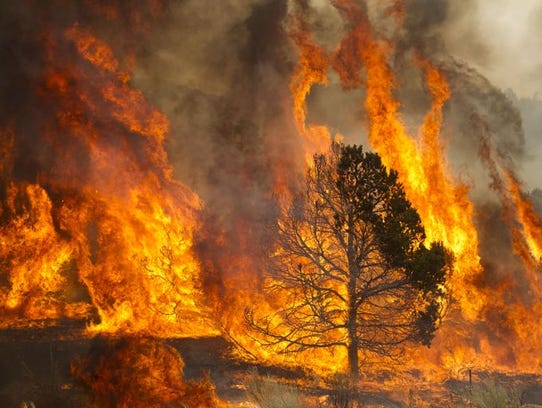
The Wallow Fire remains the largest wildfire in modern Arizona history. (Photo: Rob Schumacher/The Republic)
10 of the biggest wildfires since 2002
Today’s wildfires are bigger than they once were. That’s no guarantee that this fire season will be bigger than the last, but in 2002, when the Rodeo-Chediski fire burned about 468,638 acres, Arizona got a glimpse of what a century of fire suppression, climate change and a spark can lead to.
High Country News reports that not only are large wildfires more common, but the fire season is also longer.
Two wildfires burning in parts of Arizona were not posing an immediate threat to any residents and at least one was being allowed to continue burning, according to officials.
The Peña Fire had burned about 300 acres of mostly grass and brush as of Tuesday night in an area south of Peña Blanca Lake west of Nogales, Coronado National Forest officials said.
The second major fire was burning about 6 miles south of Globe, west of State Route 77, in the Pinal Mountains.
The Pinal Fire was caused by lightning on May 8, according to Tonto National Forest officials.
It had burned about 206 acres as of Tuesday and was zero percent contained, but crews were working the fire as a natural prescribed burn to help prevent future fires, noting the area had not experienced a fire since 1952, when 36 lightning strikes were recorded, said Andrew Mandell, incident commander.
For the past decade, Coconino National Forest has burned between about 8,000 to 22,000 acres each year with prescribed fires. The cost of a controlled burn is in the thousands of dollars.
Wildfire costs — manpower, home damage, rehabilitation, property value and other costs — run into the millions.
And prescribed burns can help restore forest health after decades of fire suppression.
Authorities say at least six structures have been lost after a wind-whipped fire in Bisbee.
The fire had burned little more than five acres and was contained overnight.
Although about 50 people were evacuated Monday evening during the firefight, no overnight shelters were needed, according to the Cochise County Sheriff's Office.
No injuries were reported.
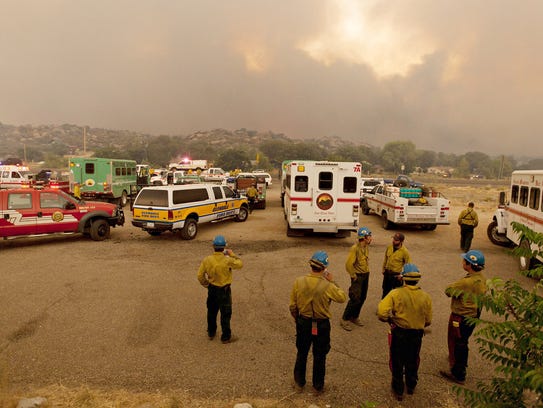
Members of the Blue Ridge Hotshots watch as the Yarnell Hill Fire advances on June 30, 2013. The crew vehicles (buggies) for the Granite Mountain Hotshots are the white vehicles parked at center and right. (Photo: Tom Story/Special for the Republic)
Father of hotshot hopes to move buggy to museum
Two buggies used by the Granite Mountain Hotshots have been put up for sale, and the father of one of the fallen firefighters hopes to turn one of the vehicles into a memorial.
Joe Woyjeck, a retired fire captain and volunteer at the Los Angeles County Fire Museum, said he would like to bring one of the buggies to the museum, to honor the 19 firefighters who died battling the Yarnell Hill Fire in June 2013.
The buggies were used to transport the hotshots to fire scenes and were in Yarnell June 30, the day the Yarnell Hill Fire killed all but one of the elite firefighters.
Woyjeck said his son, Kevin, spent a lot of time in the fire museum while he was growing up.
“All three of my children were in the museum pretty much from the time they could walk,” Joe Woyjeck said.
The Daily Courier in Prescott reported that, in addition to the buggies, the city of Prescott would like to sell Fire Station 7, where the hotshots were based.
Woyjeck said he was focused on the buggies and did not know what might happen to the fire station.
“We want to make sure at least one of the buggies is in our collection … and is treated with dignity and respect,” he said.
Although the museum will have the final say, Woyjeck said he envisions having a plaque or seat assigned to each firefighter in the back of the buggy. He also envisions a place where people can leave letters for the fallen hotshots.
Woyjeck said he expects to hear soon on the museum’s bid.
“There’s no agenda involved other than honoring those 19 firefighters. … We’re keeping our fingers crossed.”
